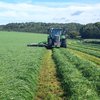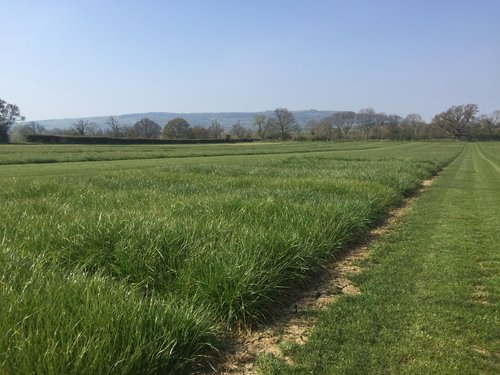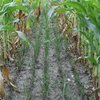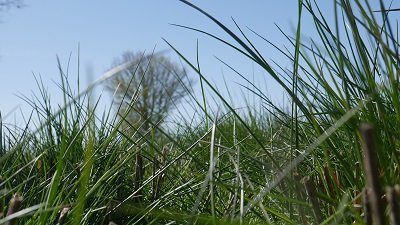Bar Tech April 2021
Welcome to the April BarTech with thoughts, tops tips and advice from the UK Grass Experts.

Welcome to the April BarTech with thoughts, tops tips and advice from the UK Grass Experts.
The prolonged dry weather has brought some much-needed heat during the day, and the end of frost at night, but is also causing havoc with grass swards across the country as they continue to be restricted, and below average.
In some areas, cattle are already out and content to be at grass but in others, where sheep have been winter grazing or where soil temperatures are cooler and dry, swards have been slow to react and it is tempting to keep stock housed.
An early turnout of cattle in the spring has many benefits including reduced labour hours, more contented stock and cheaper liveweight gain/milk production. Economically, more expensive feeds can be displaced by grass and an early turnout of stock will increase the quality of grass in subsequent rotations.
…but when to graze?
In an ideal world, grass is grazed early to allow re-growth for the second rotation, and of course you must ensure grass does not run out before your second rotation begins. Remember, grazing grasses too early, before the second new leaf tiller appears, can damage grass persistency. If a plant’s reserves have not been fully restored, future growth will be in jeopardy. It is easier to cut and round bale excess grass than it is to start buffer feeding when swards become depleted so always err on the side of caution when choosing fields for grazing and allow a little more than you think will be required.
When in a grazing cycle, the two main obstacles faced when managing swards are soil conditions and rainfall. Be careful with heavy land, especially after periods of rain as poaching of swards can reduce growth rates by as much as 20%. Visual checks of your fields will soon bring any issues to your attention and simple things like on/off grazing or temporarily moving stock to drier land will help alleviate any ground condition issues.
Grazing swards in prolonged dry spells of weather can be equally testing, both in terms of production and patience! It is important to maintain grass covers by reducing demand where needs be by using a supplement forage or concentrate. It is likely that the dry matter content of swards will have increased significantly so paddocks should in theory last longer. Give some consideration to strip grazing paddocks rather than block grazing during a dry period as anything not grazed down to 4cm is wasted forage but ensuring the grass is not overgrazed.
Monitor your swards pre and post grazing.
Before stock start to graze a sward, carry out a visual assessment and look for any issues that may affect production later in the year. Early action on broad leaved weeds prevents an unmanageable infestation later in the year. Ask yourself the questions each time you walk through a field; Is your sward dense enough to carry animals when grazing without poaching? Is your grass a healthy green colour or is it starting to show signs of stress? Patchy areas in your sward can indicate compaction and poor soil structure. Order your free Sward Stick
Visual checks after grazing could perhaps identify grasses that haven’t been eaten off as well as others. Perhaps the seed mixture used in this field isn’t ticking all the boxes or perhaps annual meadowgrass and other weed grasses are starting to take over, your animals will soon tell you whether or not they like what is in front of them! Making all of these observations will help you identify which swards need over-seeded or re-seeded. In an ideal world at least 15% of your grazing fields should be re-seeded every year but we know that isn’t always possible. Re-seed where you can and if other swards need a boost for a couple of years then over-seed with varieties that have been tested based on density, palatability and yield.


As social media is filled with photos and videos of first cut...
As social media is filled with photos and videos of first cut silage from across parts of the country, for many farmers silage is a few weeks away. However, there is no doubt leafy silage with higher dry matter intake will result in better feed intakes, resulting in healthier more productive cattle. Farmers who are making their first cut early will reap the benefits of top-class forage later this year...... keep reading.
 Activity at Cropvale has increased and two of the trials on site have had the first harvest cuts of 2021; these trials are the Italian and Hybrid Ryegrasses Varieties Trial and the Simulated Grazing Trial.
Activity at Cropvale has increased and two of the trials on site have had the first harvest cuts of 2021; these trials are the Italian and Hybrid Ryegrasses Varieties Trial and the Simulated Grazing Trial.
In common with most areas of the country, grass growth has been slow this spring due to frosty nights and dry weather. The Italian and Hybrid Varieties Trial demonstrates their importance in these conditions, growing in cooler soil temperatures.
The Italian and Hybrid Ryegrasses Varieties Trial was sown in autumn 2019 and is now in the second harvest year. This trial includes a selection of new varieties from Barenbrug breeding stations around the globe and varieties already successfully being used by farmers from Barenbrug globally. The trial will be used to see if they are viable and have potential for use in UK agriculture. If these varieties are successful in our trial site they would be put forward for independent testing and trials to potentially appear in UK recommended lists in 2030! Italian and Hybrid ryegrass species grow at lower soil temperatures which means they are ready to utilise earlier in the growing season. This early cut can attribute to around 10 – 15% of the total annual yield over a five cut system.
The Simulated Grazing Trial includes predominately perennial ryegrass varieties and was sown in autumn 2020. These trials run continuously at Cropvale, testing the yields, persistency, and several other factors of different varieties, including current and upcoming varieties being introduce in the next few years, to ensure we continue to offer the best varieties to market. It will be harvested 8 – 9 times per year, dependant on the growing season, to mimic rotational grazing by livestock. Generally, simulated grazing yields will be around 2/3 of what you would expect from silage management throughout the year. The first cut was taken at the end of March and although yields were low, a recent rain on a fertilised trial has seen a growth spurt and a second cut will need to be taken soon.
Both trials are recovering well, albeit everywhere could do with some consistently warmer temperatures and a good steady supply of rain.


The benefits of growing a maize crop to feed to livestock and AD...
The benefits of growing a maize crop to feed to livestock and AD plants are well known however there are some key issues that farmers face. Find out how undersowing with Barenbrug grass varieties, and dedicated Proterra Mazie mixture, can help... find out more
 Barenbrug grass seed growers have been busy this year already with spring sown grass seed, due to be harvested in 2022, being sown with companion cereal crops, into good seedbeds during February and March, and starting to emerge. The cold, dry spring has caused some seed beds to dry out rapidly and, at the time of writing, we are desperate for rain to help establish some of the later drilled varieties. Irrigation is taking place on some lighter soil types to help with emergence and yield potential.
Barenbrug grass seed growers have been busy this year already with spring sown grass seed, due to be harvested in 2022, being sown with companion cereal crops, into good seedbeds during February and March, and starting to emerge. The cold, dry spring has caused some seed beds to dry out rapidly and, at the time of writing, we are desperate for rain to help establish some of the later drilled varieties. Irrigation is taking place on some lighter soil types to help with emergence and yield potential.
Italian Ryegrass species are starting to be silaged this week, and rain is forecasted in some parts of the UK next week. The rain will help the recovery process that these crops require to grow on to for seed, which will be harvested in late July.
Crop inspections have started taking place on some species and will run through until the beginning of June. Application of growth regulators is very challenging this year and most growers have taken the decision to hold off until warmer weather arrives to prevent crop damage and potential crop yield losses.
Disease levels remain low, driven mainly by the cool, dry weather and very little fungicide has been applied.
Planning is well under way for autumn sown crops for harvest 2022 and the ordering of the basic seed for these crops will be placed in June to enable sowing to commence in late August.
Discover our range of grass, forage, clover, herb and legume mixtures for the agriculture sector.
Discover our range of grass, forage, clover, herb and legume mixtures for the agriculture sector.
Discover our range of grass, forage, clover, herb and legume mixtures for the agriculture sector.